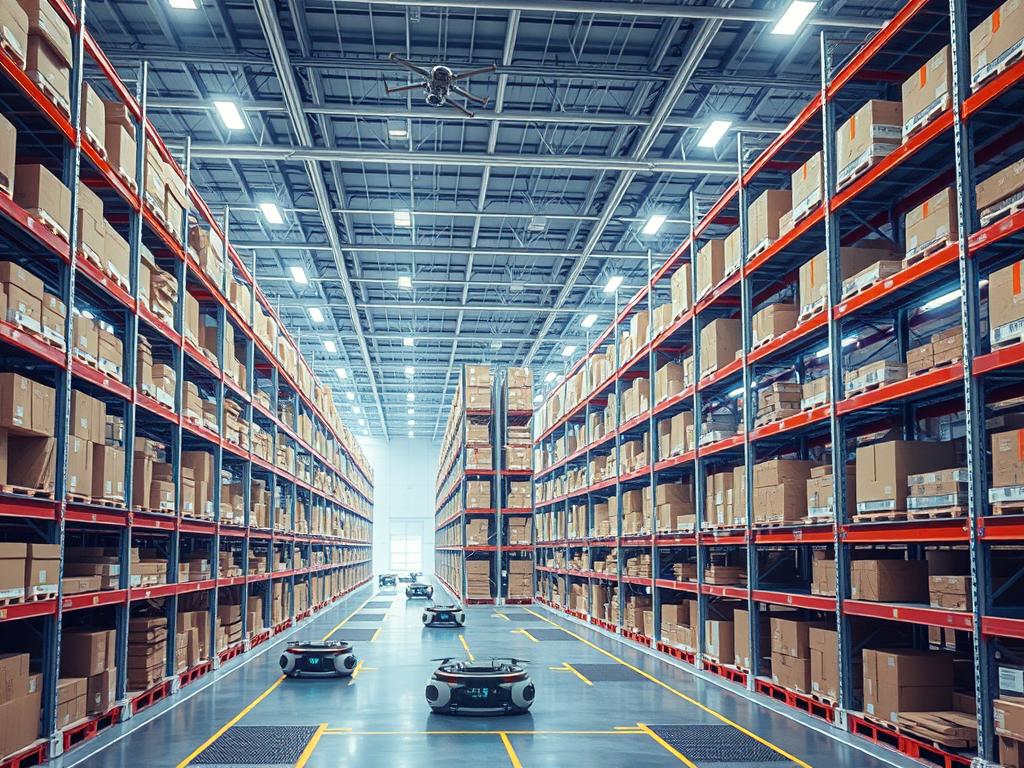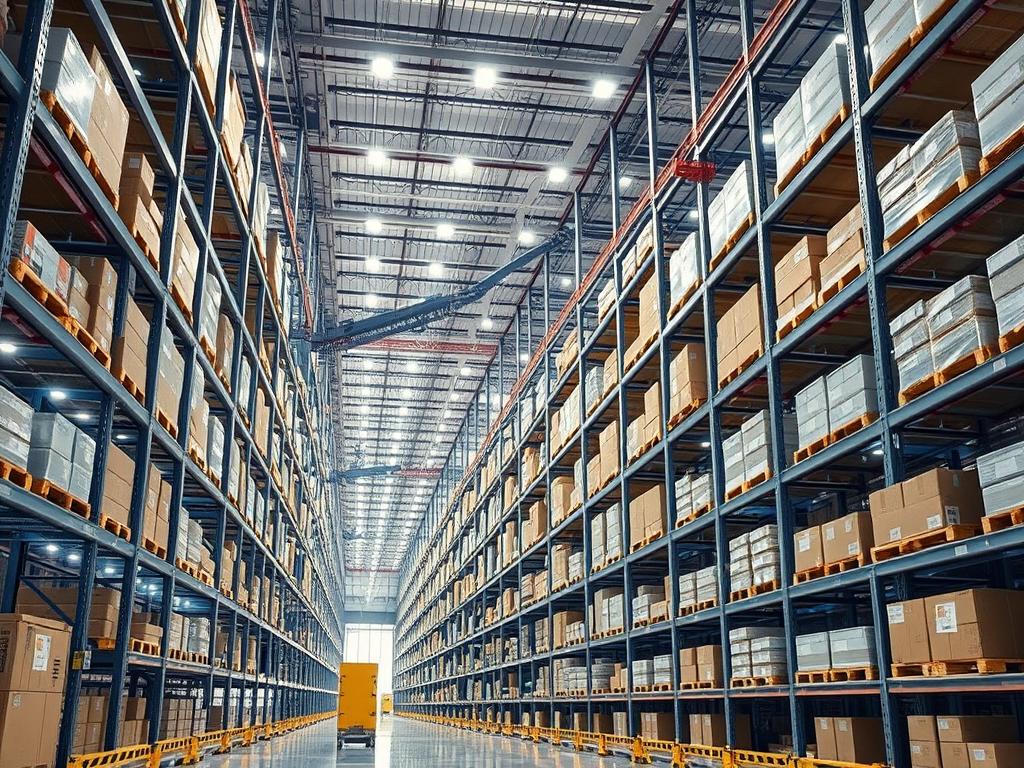Over 40% of U.S. warehouses now use automation technologies. The global warehouse automation market is growing fast. It’s expected to reach $33.34 billion by 2026, with a 13.60% CAGR.
Fully automated warehouse systems are changing supply chain operations. These solutions use advanced tech to streamline workflows without manual intervention. They improve materials handling, inventory management, and order fulfillment.
These systems have a big impact on logistics. Automated warehouses work 24/7 with near-perfect accuracy. They achieve very high productivity levels.
This guide explores how to set up autonomous warehouse operations. We’ll look at the tech, benefits, and challenges of this new approach.
Warehouse automation solves key industry problems. Labor costs can be up to 65% of warehouse budgets. Automation isn’t just an upgrade; it’s crucial for staying competitive.
What is a Fully Automated Warehouse System?
Fully automated warehouses transform storage and distribution. These smart solutions use advanced tech to improve operations. They streamline processes from receiving to shipping.
Definition and Key Features
Robotic systems manage tasks without human help in automated warehouses. They use cutting-edge tools to boost efficiency.
- Autonomous vehicles for material transport
- Robotic arms for picking and packing
- RFID technology for real-time tracking
- Computer vision for quality control
Types of Automation Technologies
Warehouse automation includes various tech solutions:
| Technology | Function | Benefit |
|---|---|---|
| AGVs | Material handling | Reduced labor costs |
| AS/RS | Storage and retrieval | Space optimization |
| AMRs | Flexible transport | Increased efficiency |
Benefits of Automation in Warehousing
Automated inventory management offers many perks:
- 25% reduction in order picking time
- 3x increase in logistics operations speed
- 80% rise in average order value
- Enhanced inventory accuracy

AI in logistics is growing fast. The market could reach $565.82 billion by 2033. This shows more industries are using automated warehouses.
“By 2030, many logistics operations could be automated, with fully automated high-rack warehouses becoming commonplace.” – McKinsey
Why Implement a Fully Automated Warehouse System?
Self-operating warehouse systems are changing logistics operations. They offer benefits that drive businesses to adopt smart warehouse technologies. These cutting-edge solutions are transforming the industry.
Increased Efficiency and Productivity
AI-driven warehouse optimization boosts efficiency dramatically. Automated systems can achieve picking speeds up to 300 lines per hour. Some solutions even reach 550 lines per hour per operator.
This leads to 24/7 operations and significant labor savings. Companies can meet demands faster and more effectively.

Reduced Operational Costs
Smart warehouse technologies cut costs in multiple ways. They maximize space utilization, saving up to 90% of floor space. Labor expenses decrease as automation handles repetitive tasks.
The return on investment for automated solutions often comes within 6-18 months. This quick payback makes them attractive to businesses.
Improved Accuracy and Inventory Management
Fully automated warehouse systems excel in precision. Advanced picking solutions can achieve up to 99% accuracy rates. This level of precision enhances inventory control and reduces waste.
Improved accuracy also leads to better customer satisfaction. Customers receive the right products faster and more reliably.
| Benefit | Impact |
|---|---|
| Picking Speed | Up to 300 lines per hour |
| Accuracy Rate | Up to 99% |
| Space Savings | Up to 90% of floor space |
| ROI Timeline | 6-18 months |
Self-operating warehouse systems are crucial for staying competitive. They offer a path to sustainable, efficient operations. As e-commerce grows and labor shortages persist, automated solutions become increasingly vital.
Key Components of Fully Automated Warehouse Systems
Cutting-edge tech powers fully automated warehouse systems. They boost efficiency, cut errors, and make the most of space. Let’s dive into the main parts of these systems.
Automated Storage and Retrieval Systems (AS/RS)
AS/RS is the heart of modern warehouses. Robotic cranes and conveyors store and fetch items precisely.
A Brazilian case study shows a clad-rack warehouse with twin-mast stacker cranes. These cranes serve two aisles, showing AS/RS at work.

Robotics and Autonomous Vehicles
Robots are vital in warehouse automation. Automated Guided Vehicles (AGVs) and Autonomous Mobile Robots (AMRs) move materials and pick orders.
By 2025, experts predict widespread use of collaborative mobile robots. These will boost both productivity and accuracy.
Warehouse Management Software (WMS)
WMS is the brain of automated warehouses. It manages operations, gives real-time updates, and helps make data-driven choices.
Cloud-based WMS offers lower infrastructure costs. It also provides more flexibility for warehouse operations.
| Component | Function | Benefits |
|---|---|---|
| AS/RS | Storage and retrieval | Space optimization, inventory accuracy |
| Robotics | Material handling | Increased efficiency, reduced labor costs |
| WMS | Operation coordination | Real-time visibility, improved decision-making |
These parts work together to create an efficient, accurate warehouse. As tech improves, we’ll see even better integration of these systems.
This will further boost warehouse automation capabilities. The future of warehousing looks bright and highly efficient.
Steps for Implementing a Fully Automated Warehouse System
Transitioning to a fully automated warehouse system requires careful planning. Let’s explore the key steps for a successful implementation. These steps will help streamline your warehouse operations.
Conducting a Needs Assessment
Start with a thorough needs assessment of your warehouse. Analyze current operations and identify bottlenecks. Set clear objectives for automation improvements.
This evaluation will pinpoint areas that need automation most. It helps create a focused strategy for your warehouse upgrade.
- Analyze current workflows and processes
- Identify operational inefficiencies
- Set specific automation goals
Choosing the Right Technology Partners
Selecting the right automation technology is crucial. Look for partners with expertise and a solid track record. Their solutions should be scalable to meet your future needs.
Collaborate with providers who understand your unique requirements. Implementing a fully automated warehouse system demands experienced partners.
Developing a Comprehensive Implementation Plan
A well-structured plan ensures a smooth transition to automation. Your plan should cover key aspects of the implementation process.
| Component | Description |
|---|---|
| Timeline | Realistic schedule for each phase of implementation |
| Budget | Detailed cost breakdown for equipment, software, and training |
| Risk Management | Strategies to address potential challenges during implementation |
| Training Plan | Comprehensive program to educate staff on new systems |
These steps lead to successful warehouse automation. They improve efficiency and reduce costs. Your operational capabilities will be enhanced through this process.
Real-World Applications Across Various Industries
Fully automated warehouse systems are transforming operations in many sectors. They offer custom solutions for unique industry challenges. These systems boost efficiency and accuracy in remarkable ways.
E-commerce: Speed and Flexibility
E-commerce automation is changing online retail. Companies now process thousands of orders daily with same-day shipping. Some businesses use advanced AS/RS tech to handle over 40,000 orders per day.
This speed meets customer expectations for fast delivery. It’s crucial in today’s competitive market.
Manufacturing: Streamlined Supply Chain
Automation is reshaping manufacturing supply chains. It ensures just-in-time inventory and efficient production flow. The Manitou Group in France processes 500 order lines hourly with their shuttle system.
This boost in productivity applies to spare parts handling. Automated warehouses help some manufacturers process over 22,000 tonnes of materials yearly. They produce millions of units as a result.
Grocery Distribution: Freshness and Accuracy
Automated systems are vital for grocery distribution. They maintain product freshness and order accuracy. These systems are crucial for perishable goods.
A Brazilian food company increased productivity by 20% with automated warehouses. They used this tech for frozen and refrigerated products. It ensures groceries reach consumers in top condition.
| Industry | Automation Impact | Example |
|---|---|---|
| E-commerce | 40,000+ daily orders | Advanced AS/RS systems |
| Manufacturing | 500 order lines per hour | Manitou Group’s shuttle system |
| Grocery | 20% productivity increase | Brazilian food company’s automated warehouses |
These examples show how automated warehouses solve industry challenges. They drive efficiency and improve customer satisfaction. Across sectors, the impact is clear and significant.
Challenges and Considerations for Implementation
The warehouse automation market is growing rapidly. Projections show it reaching $41 billion by 2027. Implementing these systems comes with significant challenges for businesses.
High costs, integration issues, and employee training needs are key hurdles. Careful planning is essential to overcome these obstacles effectively.
High Initial Investment Costs
Automation solutions require substantial upfront investment. Hardware, software, and training expenses can put a strain on budgets. Companies should analyze costs and benefits thoroughly.
Long-term savings often outweigh initial costs. However, careful financial planning remains crucial for success.
Integration with Existing Systems
System integration poses technical challenges. Compatibility issues and data silos can disrupt smooth operations. Ensuring scalability and seamless integration with partners is vital.
Warehouse automation technology must adapt to changing e-commerce needs. This flexibility helps avoid costly rework down the line.
Employee Training and Change Management
Transitioning to automated systems requires comprehensive employee training. Upskilling the workforce to manage new technologies is essential. Change management strategies help staff adapt to new roles.
Regular training for maintenance staff ensures system reliability. This ongoing education is key to maximizing the benefits of automation.
| Challenge | Solution |
|---|---|
| High initial costs | Cost-benefit analysis, long-term planning |
| Integration issues | Compatibility testing, scalable infrastructure |
| Employee adaptation | Comprehensive training, change management |
Addressing these challenges requires a strategic approach. Careful planning helps businesses overcome hurdles effectively. This approach ensures increased efficiency and productivity in warehouse operations.
Future Trends in Automated Warehouse Systems
Warehouse automation is changing fast due to new tech and efficiency needs. Several key trends are shaping the future of automated warehouse systems. These trends promise to boost productivity and revolutionize operations.
Advancements in AI and Machine Learning
AI will play a crucial role in improving warehouse operations. 42% of warehouses plan to invest more in AI. This shift leads to more predictive and adaptive systems.
Smart solutions can forecast demand with high accuracy. They also optimize inventory management and predict maintenance needs. These improvements can reduce machine downtime by 30-40%.
Sustainability and Green Automation Solutions
Sustainable warehouse solutions are becoming more important. Businesses aim to reduce their environmental impact. Energy-efficient lighting and space-optimizing tech help cut carbon footprints.
German retailer Bergfreunde is a great example. They reduced CO2 emissions per package by 30% after using an AutoStore system.
The Role of IoT in Warehouse Automation
IoT warehouse technology creates more connected and intelligent systems. IoT devices improve real-time inventory tracking and operational visibility. They also help optimize performance.
This connectivity, combined with advanced robotics like AMRs, is changing material handling. It’s also increasing warehouse agility. The AMR market may reach $4.1 billion by 2028.
This growth shows the importance of IoT and robotics in warehouse operations. These technologies are reshaping the future of automated warehouses.


